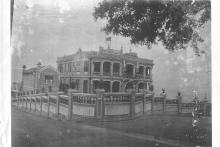Tak Wing NG [????-????]
Primary tabs
Statement by Ng Yau Lin,) wife of Ng Tak Wing, 7th October 1945.
“My husband began to work for the BAAG about October 1942. He made 2 trips to Waichow without mishap ... The Japanese Gendarme Ishii accompanied by the Chinese named Ip Wai came to our residence No.456 Nathan Road and asked for Ng Tak Wing. I replied he did not always sleep at home and at that time was out. They then searched the place. A week or so later they came again and after that made periodic visits. On my husband’s return I told him of their visits. .... He only stayed two or three days each time and managed to avoid arrest for 5 or 6 trips until 30th April 1943 when Ip Wai and another Chinese found him at home about 6 pm. He was taken away to the Central Police Station and was never seen again. Some days after the arrest Ip Wai came and searched my place. No papers of any kind were found but he took away a radio set and over M.Y. 100. He also told me that Ng Tak Wing was all right, was in Stanley at that time and would not be executed”.
Executed in October 1943. BAAG Roll of Honour.


Comments
'Ginger Salter' is presumably
'Ginger Salter' is presumably Royal Scots Private C. P. ('Charlie') Salter (a man with 'bushy, flaming hair'), who escaped from Hong Kong on February 4, 1943.. Ellen Field seems to have played a role in this escape, although she dates all of her escape work to April-late August 1942. Salter walked out of Shamshuipo at a very early stage and spent the next year hiding with his Eurasian girlfriend, who Field calls Alicia. Alicia goes to Hahn for help in organising an escape, she approaches Selwyn-Clarke, who refuses to have anything to do with the matter, and a couple of days later an unknown Chinese man turns up at her door.. He knows - how is never explained - she's harbouring a soldier, and disarms her suspicions by showing a Chungking identity card with the signature of a British officer. After disguising Salter's give-away hair colour, Field accompanies the pair on a bus through Kowloon to act as a diversion in the event of trouble. The same man brings back proof of Salter's success, and Field helps him with further escapes.
Salter gave a rather different account to the BAAG, although he did mention Field as someone who helps the British. However, in the late 1960s or early 1970s he was interviewed by Tim Carew for his book 'Hostages to Fortune' and his story there is similar to that of Field. It's possible that some of the details in his wartime version were designed to explain his rather long sojourn in Kowloon before attempting escape.